Budgeting and Variance Analysis Report: Finance in Hospitality
VerifiedAdded on 2024/05/17
|8
|1321
|148
Report
AI Summary
This report discusses financial controls within the hospitality industry, focusing on budgetary control processes and variance analysis. It highlights the importance of judicious resource utilization, departmental budget preparation, and deviation analysis. The report outlines the steps in budgetary control, including estimation, preparation, circulation, comparison, and corrective measures. It analyzes sales, material price, material usage, labor rate, and labor efficiency variances, providing insights into their causes and suggesting appropriate management actions for future improvements. The conclusion emphasizes the need to follow budgetary steps to achieve business objectives and manage variances effectively.
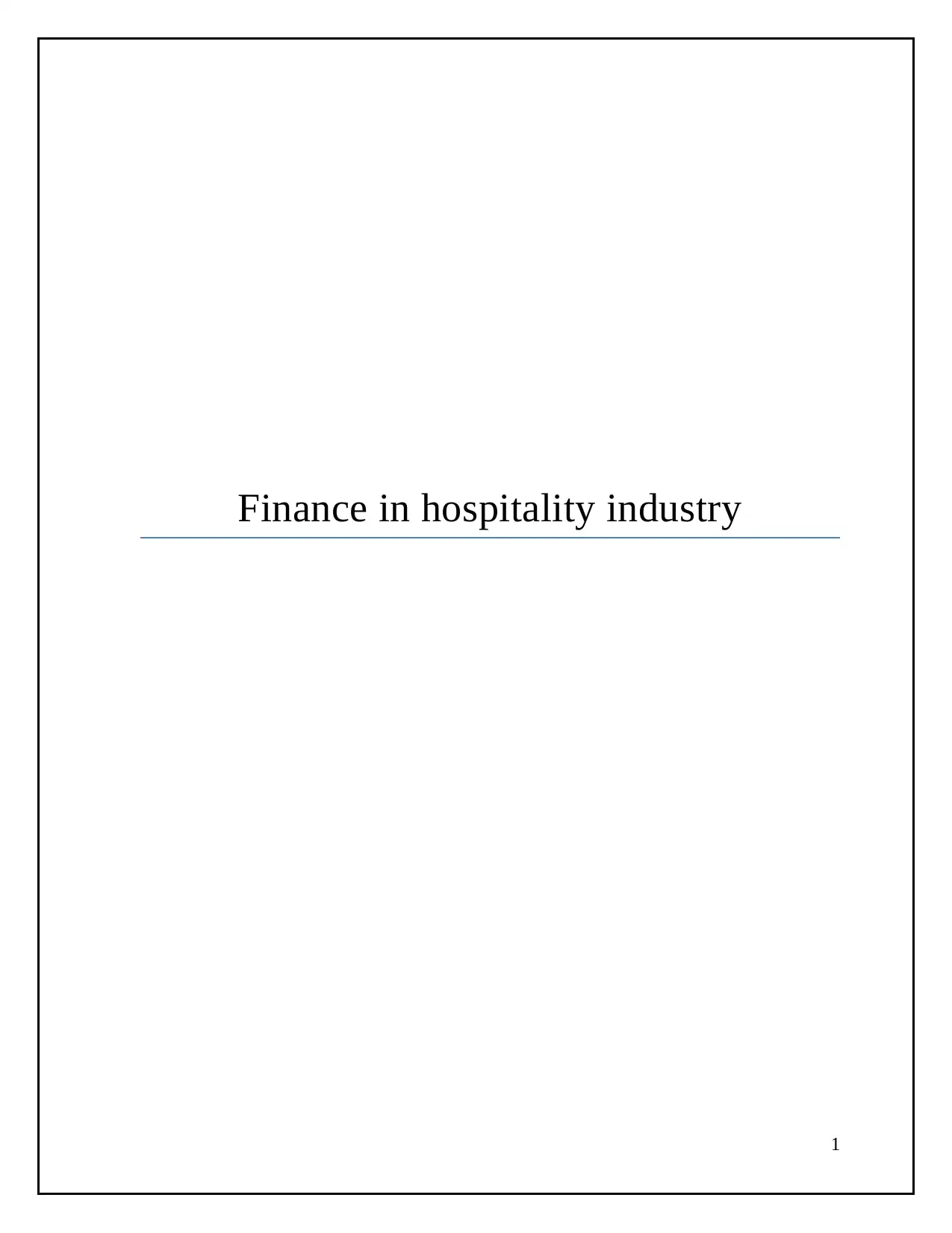
Finance in hospitality industry
1
1
Paraphrase This Document
Need a fresh take? Get an instant paraphrase of this document with our AI Paraphraser
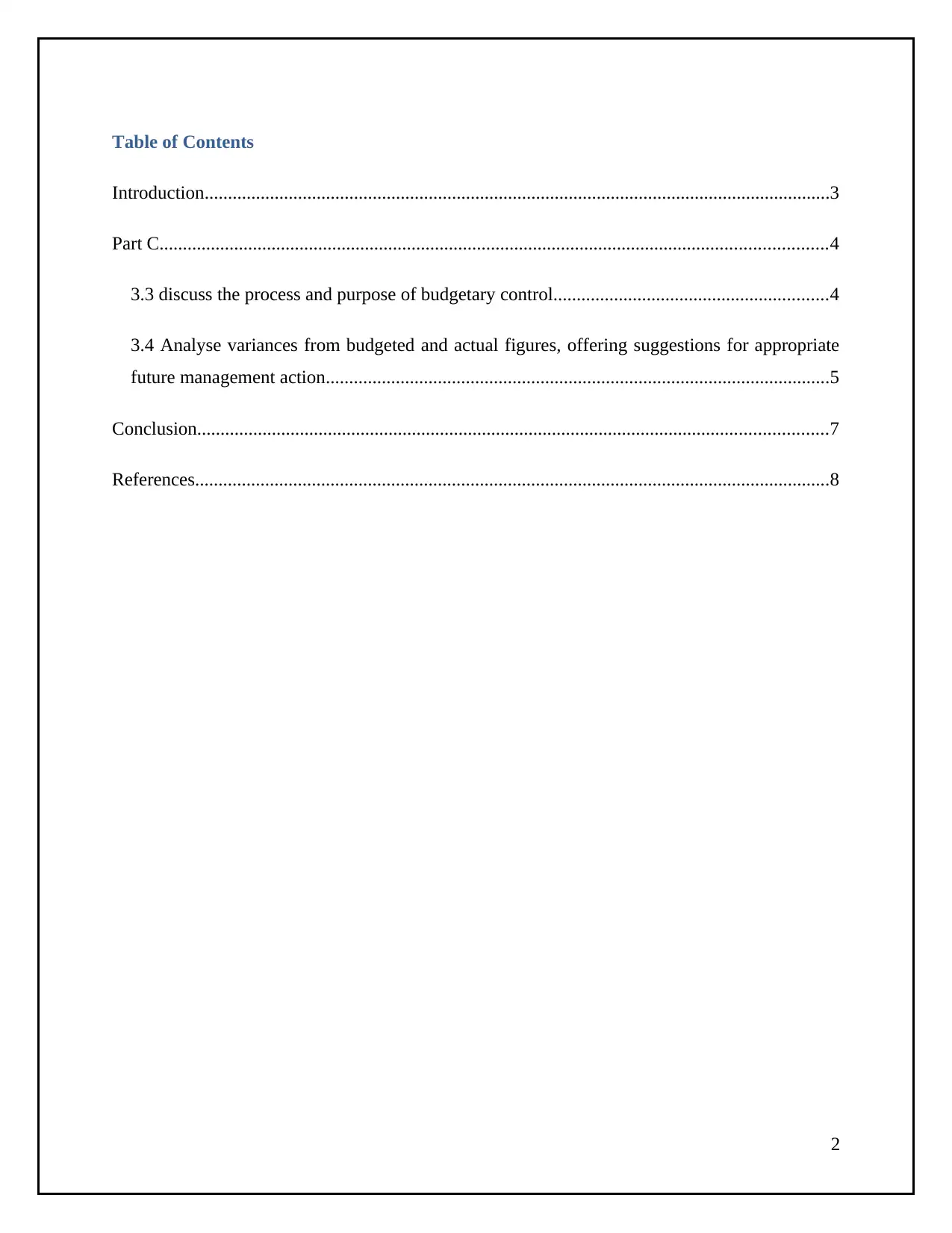
Table of Contents
Introduction......................................................................................................................................3
Part C...............................................................................................................................................4
3.3 discuss the process and purpose of budgetary control...........................................................4
3.4 Analyse variances from budgeted and actual figures, offering suggestions for appropriate
future management action............................................................................................................5
Conclusion.......................................................................................................................................7
References........................................................................................................................................8
2
Introduction......................................................................................................................................3
Part C...............................................................................................................................................4
3.3 discuss the process and purpose of budgetary control...........................................................4
3.4 Analyse variances from budgeted and actual figures, offering suggestions for appropriate
future management action............................................................................................................5
Conclusion.......................................................................................................................................7
References........................................................................................................................................8
2
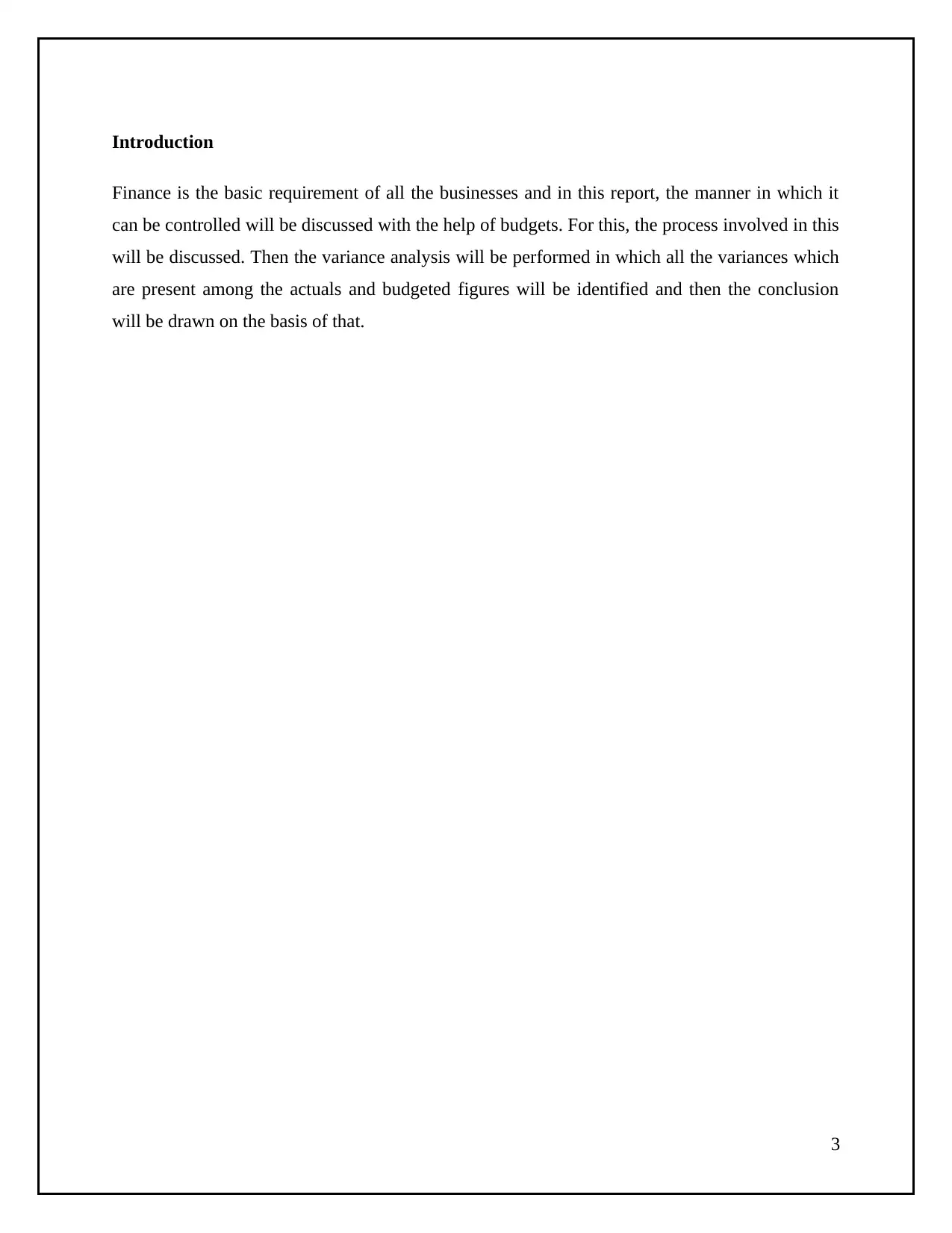
Introduction
Finance is the basic requirement of all the businesses and in this report, the manner in which it
can be controlled will be discussed with the help of budgets. For this, the process involved in this
will be discussed. Then the variance analysis will be performed in which all the variances which
are present among the actuals and budgeted figures will be identified and then the conclusion
will be drawn on the basis of that.
3
Finance is the basic requirement of all the businesses and in this report, the manner in which it
can be controlled will be discussed with the help of budgets. For this, the process involved in this
will be discussed. Then the variance analysis will be performed in which all the variances which
are present among the actuals and budgeted figures will be identified and then the conclusion
will be drawn on the basis of that.
3
⊘ This is a preview!⊘
Do you want full access?
Subscribe today to unlock all pages.

Trusted by 1+ million students worldwide
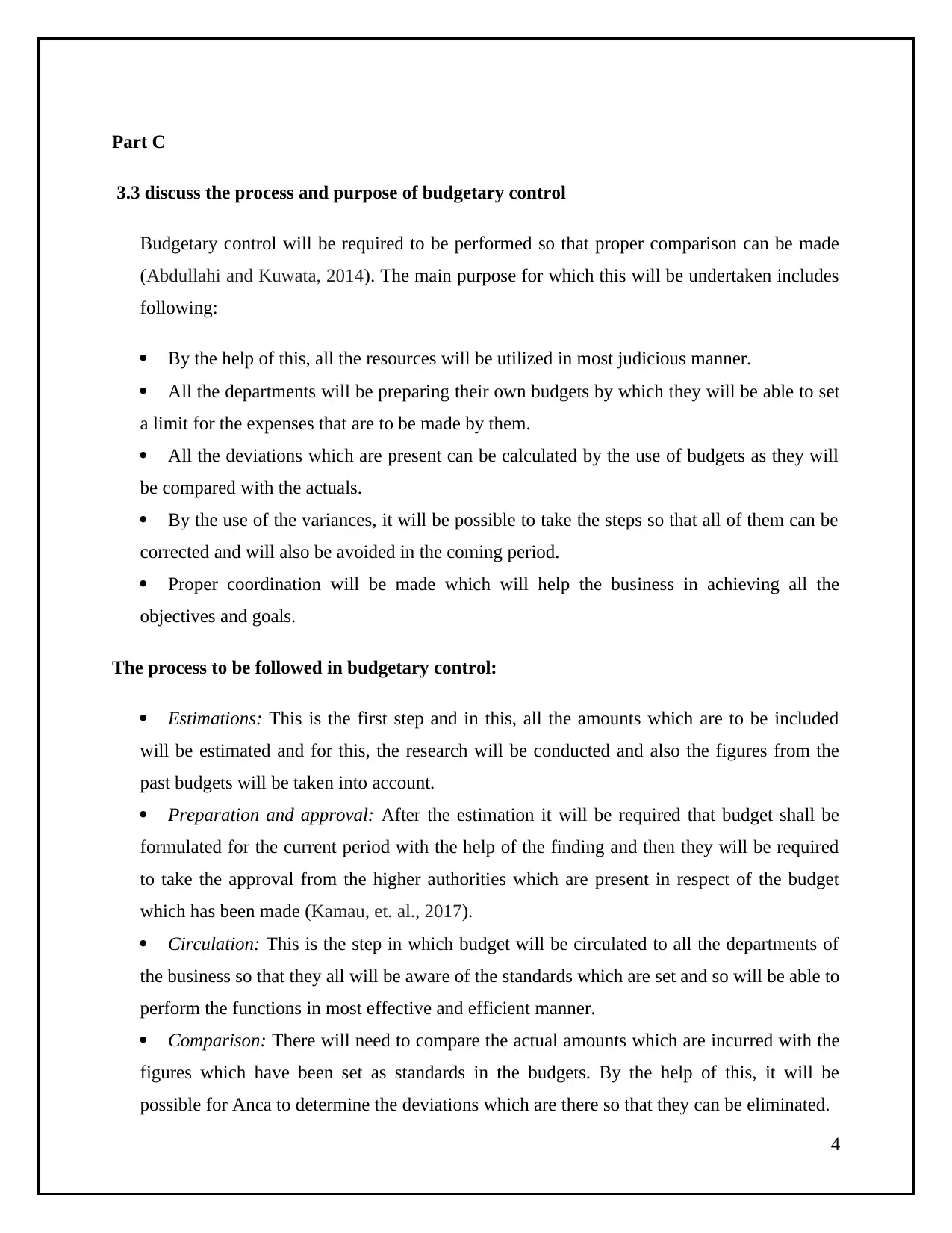
Part C
3.3 discuss the process and purpose of budgetary control
Budgetary control will be required to be performed so that proper comparison can be made
(Abdullahi and Kuwata, 2014). The main purpose for which this will be undertaken includes
following:
By the help of this, all the resources will be utilized in most judicious manner.
All the departments will be preparing their own budgets by which they will be able to set
a limit for the expenses that are to be made by them.
All the deviations which are present can be calculated by the use of budgets as they will
be compared with the actuals.
By the use of the variances, it will be possible to take the steps so that all of them can be
corrected and will also be avoided in the coming period.
Proper coordination will be made which will help the business in achieving all the
objectives and goals.
The process to be followed in budgetary control:
Estimations: This is the first step and in this, all the amounts which are to be included
will be estimated and for this, the research will be conducted and also the figures from the
past budgets will be taken into account.
Preparation and approval: After the estimation it will be required that budget shall be
formulated for the current period with the help of the finding and then they will be required
to take the approval from the higher authorities which are present in respect of the budget
which has been made (Kamau, et. al., 2017).
Circulation: This is the step in which budget will be circulated to all the departments of
the business so that they all will be aware of the standards which are set and so will be able to
perform the functions in most effective and efficient manner.
Comparison: There will need to compare the actual amounts which are incurred with the
figures which have been set as standards in the budgets. By the help of this, it will be
possible for Anca to determine the deviations which are there so that they can be eliminated.
4
3.3 discuss the process and purpose of budgetary control
Budgetary control will be required to be performed so that proper comparison can be made
(Abdullahi and Kuwata, 2014). The main purpose for which this will be undertaken includes
following:
By the help of this, all the resources will be utilized in most judicious manner.
All the departments will be preparing their own budgets by which they will be able to set
a limit for the expenses that are to be made by them.
All the deviations which are present can be calculated by the use of budgets as they will
be compared with the actuals.
By the use of the variances, it will be possible to take the steps so that all of them can be
corrected and will also be avoided in the coming period.
Proper coordination will be made which will help the business in achieving all the
objectives and goals.
The process to be followed in budgetary control:
Estimations: This is the first step and in this, all the amounts which are to be included
will be estimated and for this, the research will be conducted and also the figures from the
past budgets will be taken into account.
Preparation and approval: After the estimation it will be required that budget shall be
formulated for the current period with the help of the finding and then they will be required
to take the approval from the higher authorities which are present in respect of the budget
which has been made (Kamau, et. al., 2017).
Circulation: This is the step in which budget will be circulated to all the departments of
the business so that they all will be aware of the standards which are set and so will be able to
perform the functions in most effective and efficient manner.
Comparison: There will need to compare the actual amounts which are incurred with the
figures which have been set as standards in the budgets. By the help of this, it will be
possible for Anca to determine the deviations which are there so that they can be eliminated.
4
Paraphrase This Document
Need a fresh take? Get an instant paraphrase of this document with our AI Paraphraser
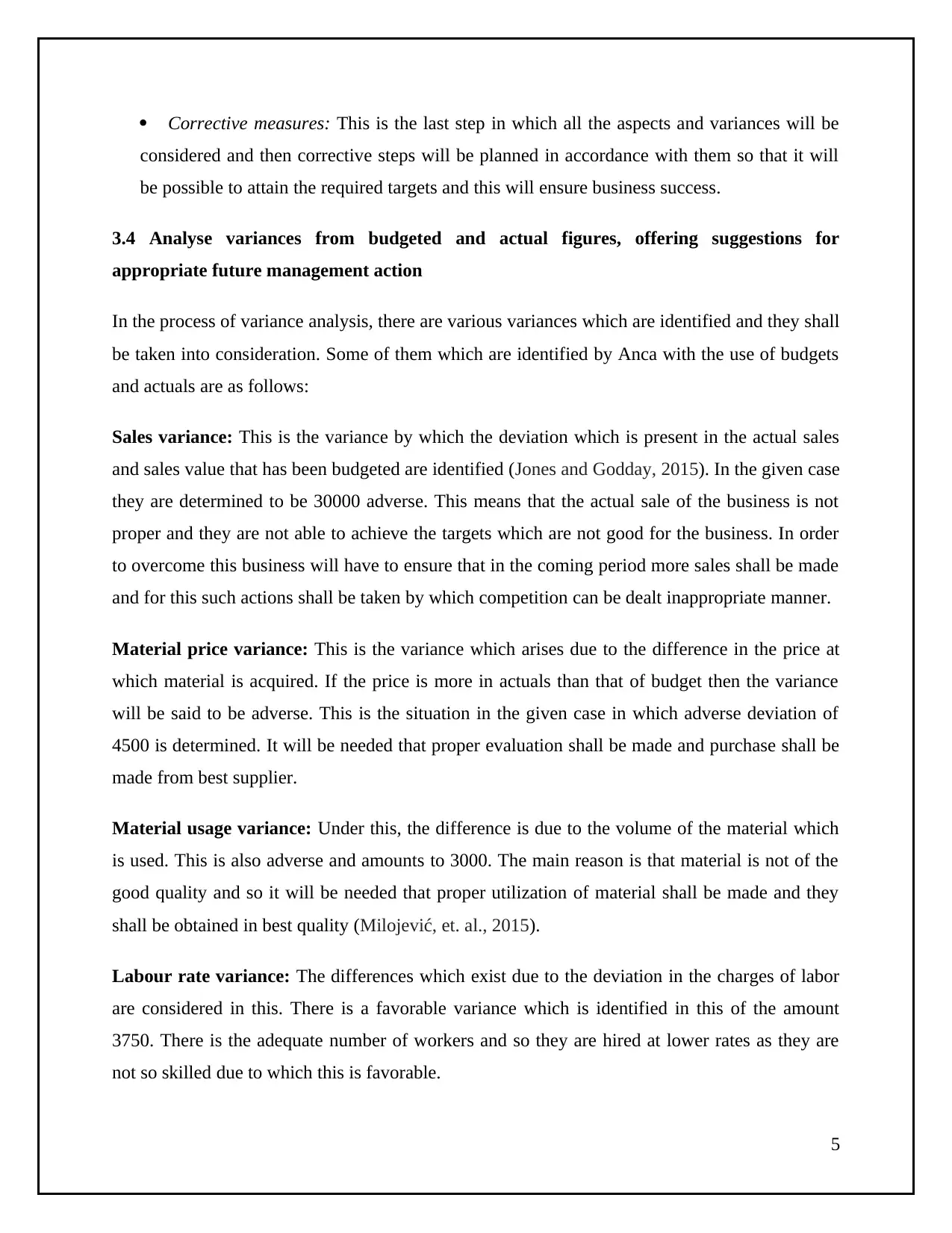
Corrective measures: This is the last step in which all the aspects and variances will be
considered and then corrective steps will be planned in accordance with them so that it will
be possible to attain the required targets and this will ensure business success.
3.4 Analyse variances from budgeted and actual figures, offering suggestions for
appropriate future management action
In the process of variance analysis, there are various variances which are identified and they shall
be taken into consideration. Some of them which are identified by Anca with the use of budgets
and actuals are as follows:
Sales variance: This is the variance by which the deviation which is present in the actual sales
and sales value that has been budgeted are identified (Jones and Godday, 2015). In the given case
they are determined to be 30000 adverse. This means that the actual sale of the business is not
proper and they are not able to achieve the targets which are not good for the business. In order
to overcome this business will have to ensure that in the coming period more sales shall be made
and for this such actions shall be taken by which competition can be dealt inappropriate manner.
Material price variance: This is the variance which arises due to the difference in the price at
which material is acquired. If the price is more in actuals than that of budget then the variance
will be said to be adverse. This is the situation in the given case in which adverse deviation of
4500 is determined. It will be needed that proper evaluation shall be made and purchase shall be
made from best supplier.
Material usage variance: Under this, the difference is due to the volume of the material which
is used. This is also adverse and amounts to 3000. The main reason is that material is not of the
good quality and so it will be needed that proper utilization of material shall be made and they
shall be obtained in best quality (Milojević, et. al., 2015).
Labour rate variance: The differences which exist due to the deviation in the charges of labor
are considered in this. There is a favorable variance which is identified in this of the amount
3750. There is the adequate number of workers and so they are hired at lower rates as they are
not so skilled due to which this is favorable.
5
considered and then corrective steps will be planned in accordance with them so that it will
be possible to attain the required targets and this will ensure business success.
3.4 Analyse variances from budgeted and actual figures, offering suggestions for
appropriate future management action
In the process of variance analysis, there are various variances which are identified and they shall
be taken into consideration. Some of them which are identified by Anca with the use of budgets
and actuals are as follows:
Sales variance: This is the variance by which the deviation which is present in the actual sales
and sales value that has been budgeted are identified (Jones and Godday, 2015). In the given case
they are determined to be 30000 adverse. This means that the actual sale of the business is not
proper and they are not able to achieve the targets which are not good for the business. In order
to overcome this business will have to ensure that in the coming period more sales shall be made
and for this such actions shall be taken by which competition can be dealt inappropriate manner.
Material price variance: This is the variance which arises due to the difference in the price at
which material is acquired. If the price is more in actuals than that of budget then the variance
will be said to be adverse. This is the situation in the given case in which adverse deviation of
4500 is determined. It will be needed that proper evaluation shall be made and purchase shall be
made from best supplier.
Material usage variance: Under this, the difference is due to the volume of the material which
is used. This is also adverse and amounts to 3000. The main reason is that material is not of the
good quality and so it will be needed that proper utilization of material shall be made and they
shall be obtained in best quality (Milojević, et. al., 2015).
Labour rate variance: The differences which exist due to the deviation in the charges of labor
are considered in this. There is a favorable variance which is identified in this of the amount
3750. There is the adequate number of workers and so they are hired at lower rates as they are
not so skilled due to which this is favorable.
5
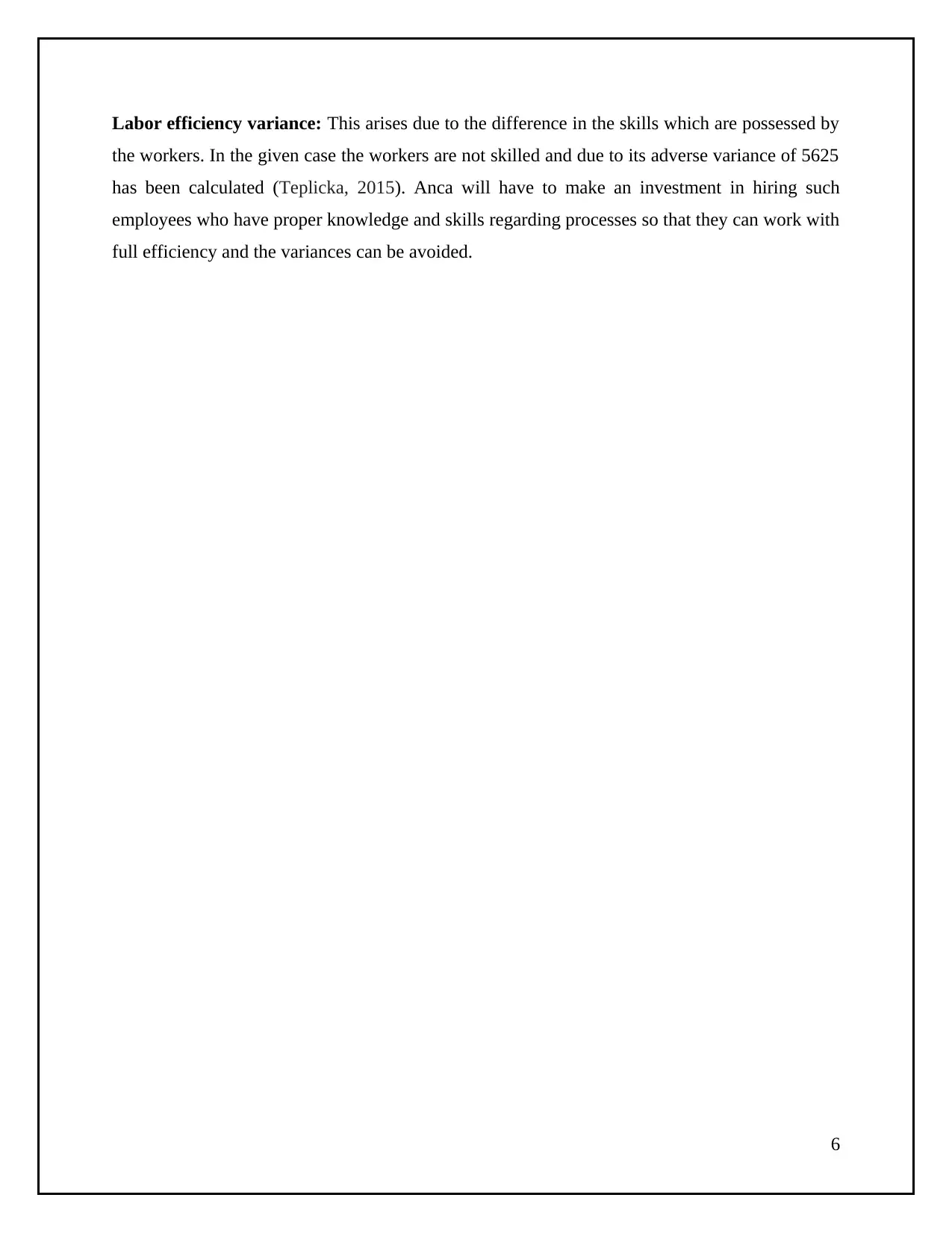
Labor efficiency variance: This arises due to the difference in the skills which are possessed by
the workers. In the given case the workers are not skilled and due to its adverse variance of 5625
has been calculated (Teplicka, 2015). Anca will have to make an investment in hiring such
employees who have proper knowledge and skills regarding processes so that they can work with
full efficiency and the variances can be avoided.
6
the workers. In the given case the workers are not skilled and due to its adverse variance of 5625
has been calculated (Teplicka, 2015). Anca will have to make an investment in hiring such
employees who have proper knowledge and skills regarding processes so that they can work with
full efficiency and the variances can be avoided.
6
⊘ This is a preview!⊘
Do you want full access?
Subscribe today to unlock all pages.

Trusted by 1+ million students worldwide
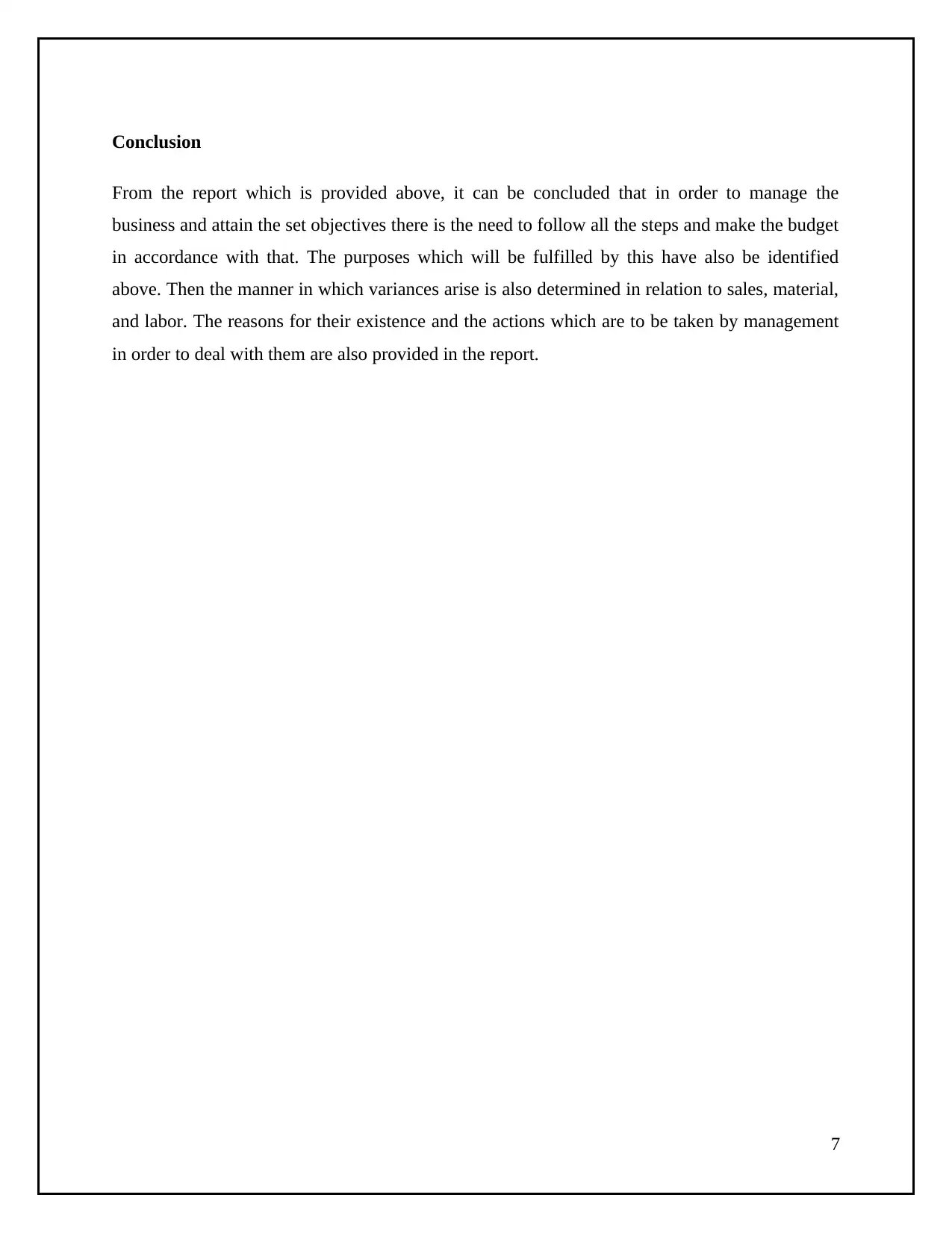
Conclusion
From the report which is provided above, it can be concluded that in order to manage the
business and attain the set objectives there is the need to follow all the steps and make the budget
in accordance with that. The purposes which will be fulfilled by this have also be identified
above. Then the manner in which variances arise is also determined in relation to sales, material,
and labor. The reasons for their existence and the actions which are to be taken by management
in order to deal with them are also provided in the report.
7
From the report which is provided above, it can be concluded that in order to manage the
business and attain the set objectives there is the need to follow all the steps and make the budget
in accordance with that. The purposes which will be fulfilled by this have also be identified
above. Then the manner in which variances arise is also determined in relation to sales, material,
and labor. The reasons for their existence and the actions which are to be taken by management
in order to deal with them are also provided in the report.
7
Paraphrase This Document
Need a fresh take? Get an instant paraphrase of this document with our AI Paraphraser
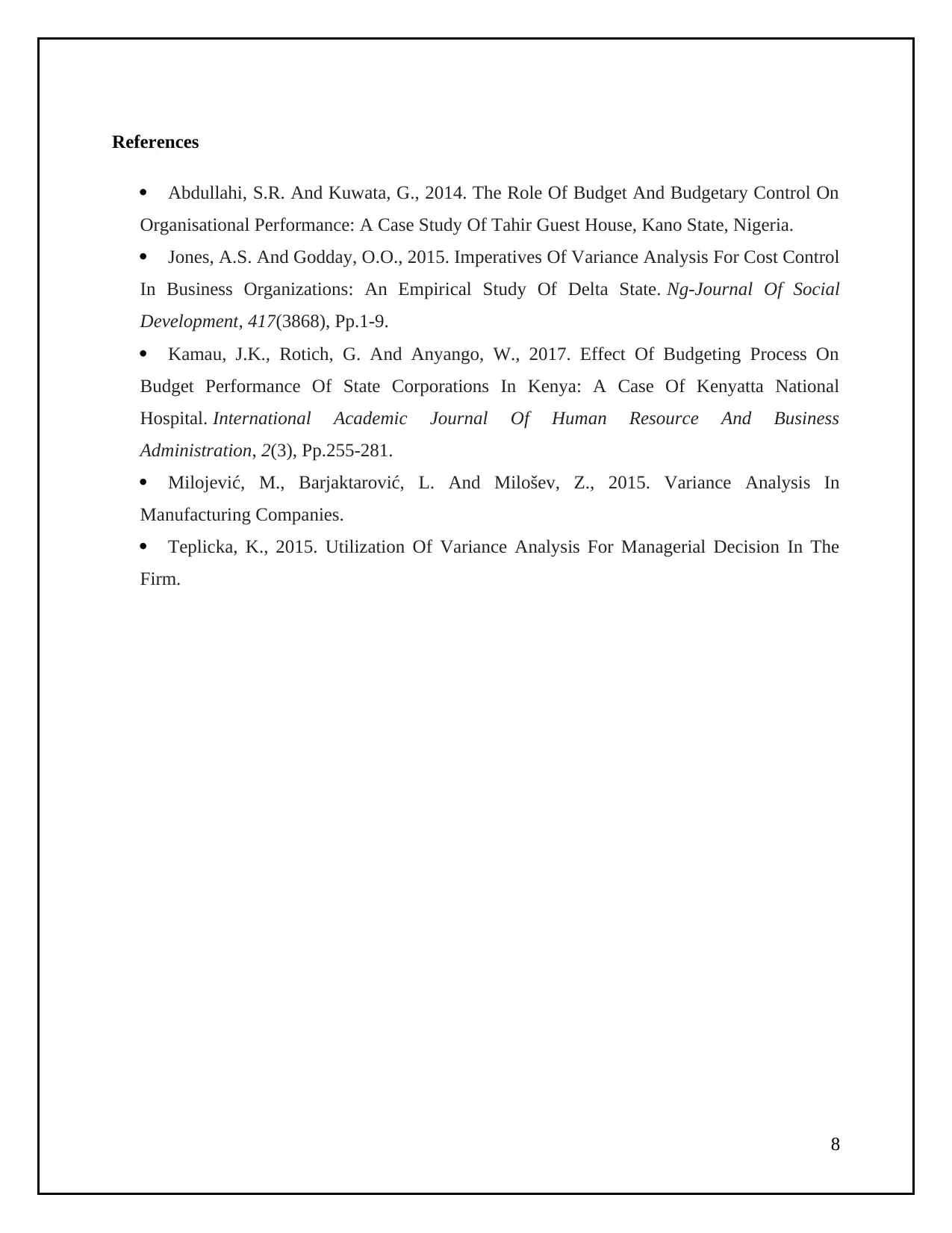
References
Abdullahi, S.R. And Kuwata, G., 2014. The Role Of Budget And Budgetary Control On
Organisational Performance: A Case Study Of Tahir Guest House, Kano State, Nigeria.
Jones, A.S. And Godday, O.O., 2015. Imperatives Of Variance Analysis For Cost Control
In Business Organizations: An Empirical Study Of Delta State. Ng-Journal Of Social
Development, 417(3868), Pp.1-9.
Kamau, J.K., Rotich, G. And Anyango, W., 2017. Effect Of Budgeting Process On
Budget Performance Of State Corporations In Kenya: A Case Of Kenyatta National
Hospital. International Academic Journal Of Human Resource And Business
Administration, 2(3), Pp.255-281.
Milojević, M., Barjaktarović, L. And Milošev, Z., 2015. Variance Analysis In
Manufacturing Companies.
Teplicka, K., 2015. Utilization Of Variance Analysis For Managerial Decision In The
Firm.
8
Abdullahi, S.R. And Kuwata, G., 2014. The Role Of Budget And Budgetary Control On
Organisational Performance: A Case Study Of Tahir Guest House, Kano State, Nigeria.
Jones, A.S. And Godday, O.O., 2015. Imperatives Of Variance Analysis For Cost Control
In Business Organizations: An Empirical Study Of Delta State. Ng-Journal Of Social
Development, 417(3868), Pp.1-9.
Kamau, J.K., Rotich, G. And Anyango, W., 2017. Effect Of Budgeting Process On
Budget Performance Of State Corporations In Kenya: A Case Of Kenyatta National
Hospital. International Academic Journal Of Human Resource And Business
Administration, 2(3), Pp.255-281.
Milojević, M., Barjaktarović, L. And Milošev, Z., 2015. Variance Analysis In
Manufacturing Companies.
Teplicka, K., 2015. Utilization Of Variance Analysis For Managerial Decision In The
Firm.
8
1 out of 8
Related Documents
Your All-in-One AI-Powered Toolkit for Academic Success.
+13062052269
info@desklib.com
Available 24*7 on WhatsApp / Email
![[object Object]](/_next/static/media/star-bottom.7253800d.svg)
Unlock your academic potential
Copyright © 2020–2025 A2Z Services. All Rights Reserved. Developed and managed by ZUCOL.





